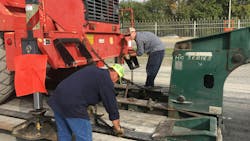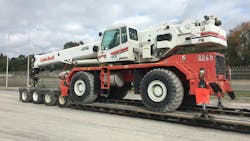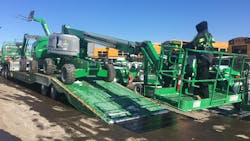Hauling heavy equipment can be a dangerous task whether the trip is across town or across state lines.
Equipment must be loaded and secured properly to protect the asset as well as avoid fines and prevent accidents. When transporting heavy machinery, proper planning ensures compliance with regulations and minimizes risks.
The risks are easy to imagine. Machines not properly secured could dislodge from a trailer or loose components could fall off during transportation. This may cause damage to the equipment and transport vehicle, as well as potentially causing a fatal traffic accident.
ConstructionEquipment.com carries news of damage, injury, or death seemingly every week. Excavator booms striking bridges. Equipment falling off trailers onto vehicles.
Failure to secure equipment properly could also result in a vehicle violation accompanied by hefty fines that can affect the company's bottom line. In addition, there's the possibility of litigation if something goes wrong.
Heavy machinery transportation is regulated by cargo securement rules issued by the Federal Motor Carrier Safety Administration within the Department of Transportation (DOT). DOT regulations for cargo securement apply to all types of cargo with additional regulations for heavy vehicles, equipment, and machinery.
Violations for improper cargo securement could result in citation fines and the vehicle being put out of service. In a pre-pandemic International Roadcheck conducted by the Commercial Vehicle Safety Alliance, nearly 22 percent of commercial motor vehicles that received Level I Inspections were placed out-of-service due to violations. Out of those citations, 13 percent of them were cargo securement violations.
Equip Trucking & Warehousing of Lester, Pennsylvania, in its outstanding Ultimate Guide for Moving Heavy Equipment & Machinery, says safe equipment transport begins with procedures for the proper loading of heavy equipment. Before equipment is transported, considerations must be made to choose the right trailer or heavy-duty hauler for each machine. Conduct safety inspections of the trailer, hauling vehicle, and equipment, and implement an appropriate securement system.
How to choose a trailer for hauling equipment
Follow these heavy equipment transportation tips for safe and efficient heavy equipment hauling.
1. Determine the weight and height of equipment.
The first step for transporting heavy equipment is to know the dimensions and weight of the equipment to be hauled. Many of the DOT regulations for cargo transportation revolve around equipment weight and size, so be sure to verify the exact height, width, and weight of equipment to guide transportation decisions.
Trailer makers such as XL Specialized, Loadall, Felling, and Eager Beaver can help in making a choice.
2. Determine if an oversize or overweight permit is needed.
Some oversized or overweight machinery may require a permit for transportation. If transporting a backhoe, dozer, dump truck, or other large piece of equipment, check the state’s requirements to see if a permit is necessary. The permit may also require additional escort vehicles that drive with the heavy hauler to alert other drivers of the oversized or overweight load.
Because transporting oversize or overweight equipment can be substantially more expensive, some companies take measures to avoid these designations. If the equipment is too heavy, consider removing all attachments and shipping them separately. If equipment is too tall, consider retracting buckets, booms, or attachments to reduce equipment height. This can lower transportation expenses as well as reducing safety risks.
3. Select the correct trailer size and capacity.
When choosing the right trailer or heavy hauler to transport equipment, look for one with the right capacity to support the cargo. Remember to account for the weight of the trailer itself when calculating the total weight the vehicle will be hauling. Determine the best placement of the equipment on the trailer to distribute the equipment’s weight as evenly as possible.
When hauling large machinery, make sure the trailer can accommodate the equipment’s height to pass safely under bridges and overpasses. The FHWA requires a minimum clearance height of 14 feet on most interstates and 16 feet on others. Choose a hauler low enough to meet this height requirement, such as a step-deck or lowboy trailer.
However, older overpasses may not meet the FHWA requirements and will be labeled with their clearance height if they are lower than 14 feet. Plan the transportation route in advance to make sure your equipment will not get stuck or need to be rerouted.
4. Inspect the trailer.
Before loading equipment onto a trailer, inspect the trailer’s anchor points to make sure they are in good shape. Look for any weak points or signs of damage that could compromise the securement of machinery. Check that the trailer is free of debris that could come loose while traveling and cause damage to other vehicles on the road.
5. Load and secure the equipment.
After trailer selection, a plan for weight and height considerations, and an inspection, it is time to load the equipment. If working with a heavy equipment hauling company, the driver will load and secure the equipment in accordance with DOT regulations. If self loading, let the heavy transport company know in advance and coordinate a pick-up time with the driver. Once the equipment is loaded onto the trailer, it must be properly secured to the transportation vehicle.
What tie-downs to use for transporting equipment
According to DOT regulations for hauling and securing heavy equipment, heavy equipment must be secured in a manner that prevents it from tipping, blowing, falling, sliding, or rolling off of the transportation vehicle while traveling. Equipment must also be unable to shift in a way that affects the maneuverability or stability of the trailer or heavy hauler. To effectively secure equipment, the securement system you choose must meet DOT minimum force requirements in each direction.
- Forward force of 80 percent of the cargo weight when braking.
- Rearward force of 50 percent of the cargo weight when speeding up, changing gears on a hill, or braking while in reverse.
- Sideways force of 50 percent of the cargo weight when switching lanes, making a turn, or braking while turning.
- Upward force of 20 percent of the cargo weight when driving over hills or bumps.
To keep machinery safe during transport, it is essential to meet all DOT requirements as well as other best practices for securing heavy equipment. Here are some additional heavy equipment transportation tips to keep in mind when securing your machinery for transport:
1. Use ample and appropriate securing devices.
When choosing the best securing devices for your heavy equipment, follow these guidelines from Equip Trucking & Warehousing:
- Use four or more tie-downs: Heavy vehicles, equipment, and machinery must be secured using no fewer than four tie-downs with a Working Load Limit (WLL) of 5,000 pounds or more. However, more tie-downs may be necessary to meet the general cargo securement requirements which specify that the total WLL of all the tie-downs needs to equal at least 50 percent of the cargo’s weight.
- Use chain when possible: When strapping down heavy equipment, use chains as your securing device whenever possible. Steel strapping is another viable option to keep your machinery safely secured.
- Tightly secure tie-downs: Attach your tie-downs using hooks, clamps, or ties that cannot come loose during transport. Make sure tie-downs are pulled tight and do not have any damage or weak sections that could break during transportation.
- Use edge protection and blocking: In addition to chains and strapping, blocking, and bracing can also be incorporated to secure your heavy equipment. Use edge protection if there is a risk of equipment components cutting tie-downs. Trailer walls and headboards can also serve as additional protection.
- Secure wheels with chocks or wedges: Heavy machinery with wheels requires additional securement, such as chocks, wedges, or cradles, to prevent it from rolling during transport. Drivers should also check the equipment tire pressure before traveling, as low tire pressure can cause tie-downs to loosen.
- Use friction devices if necessary: Equipment with metal tracks may have low friction when placed on a metal trailer or hauler. Friction mats or other friction devices can be used to provide better traction and prevent sliding.
Another critical step when securing heavy equipment during transport is to apply the parking brake on the machine. This simple step is easily overlooked, but is required by DOT regulations and helps ensure equipment cannot roll off of the trailer.
2. Choose appropriate attachment points.
When determining how to chain a dozer, backhoe, or other heavy equipment, be sure to use appropriate attachment points on both the trailer and the machinery for safety measures. Each piece of equipment will have attachment areas for tie-downs which the manufacturer has designated.
Attaching tie-downs in the wrong location could break or damage part of the equipment or fail to keep the equipment secured while on the road. Designated tie-down areas are there because they are in places where a securement system will not cause any damage to the equipment.
3. Secure equipment components.
All equipment attachments and other accessory equipment must be lowered and secured before transportation. Retract booms and buckets and secure them in place using additional tie-downs or straps. Check the equipment doors, tailgate, spare tires and any other components that could come loose or open during transportation and ensure they are locked or secured. Consider wrapping any levels, gauges, or knobs that could break or become damaged while traveling. For articulated vehicles, lock the equipment in place to prevent articulation during transport.
For equipment with an exhaust stack, be sure to cover it so debris cannot enter.
4. Verify driver visibility.
Finally, once the machine is loaded and secured, verify that the equipment and its securement system do not interfere with the driver’s view out the front or sides of the vehicle. The placement of equipment should also allow free movement of the driver and should not obstruct them from exiting the vehicle or accessing any necessary vehicle components or accessories. This ensures the driver can safely transport the machinery and keeps your company compliant with DOT regulations.
About the Author
Frank Raczon
Raczon’s writing career spans nearly 25 years, including magazine publishing and public relations work with some of the industry’s major equipment manufacturers. He has won numerous awards in his career, including nods from the Construction Writers Association, the Association of Equipment Manufacturers, and BtoB magazine. He is responsible for the magazine's Buying Files.



